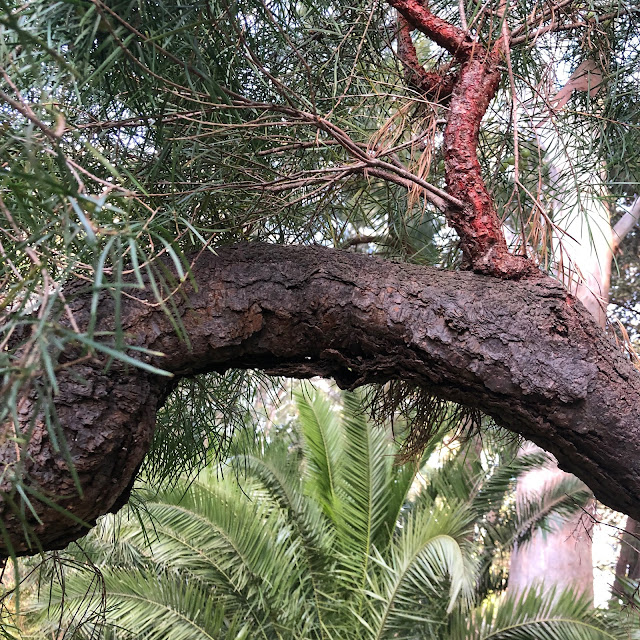 |
| The tall Euc here is a Blackbutt (Eucalyptus pilularis), while the understorey is quite a mix of natives and exotics. |
 |
| Below the Blackbutt is growing one of the largest Narrow-leafed Geebungs (Persoonia linearis) I've seen in this area. It's massive, and the distinctive dark flaky bark with rusty-orange tones underneath is clearly visible. This particular Geeing had a lot of fruit on it, not yet ripe, but hanging there in gorgeous greenish bunches. |
 |
| OK OK I can't resist sharing a shot of the Geeing fruit, nestled in among the long narrow leaves that give this species its common name. I'd love to see it growing in gardens all over Mount Pleasant, and wherever else in the escarpment foothills it'd be happy to live. |
The garden is an interesting mix of formal lawns and beds and less formal areas. The spot pictured below has a fairly formal aspect, with the Settlers Flax (Gymnostachys anceps) providing a vertical element in the central bed, and low Prickly Rasp Ferns growing around them (see following shot). The leaves of the Settlers Flax seem to be aligning with (?) echoing (?) the tall trunks of Blackbutts and Turpentines in the background. 
 |
| Prickly Rasp Fern (Doodia aspera) doing what it does best. |
A particular delight of this garden was the huge number of native seedlings popping up. They don't yet contribute to the structure or overall look of the garden, but they will do in years to come.
 |
| Classic rainforest pioneer, Bleeding Heart (Homalanthus populifolius) coming up to wreck the symmetry and order of the garden bed picture above! |
 |
| This seedling is one I've never seen in a garden before! It's a Hairy Psychotria (P. loniceroides) just hanging out happily in a dry rock wall. The recent La Niña sequences seems to have given this species a bit of a chance to recover from drought conditions, so it will be interesting to see how the new plants go over the next few years. Hairy Psychotria can grow to around 3m tall and has gorgeous translucent green-yellow fruit. |
 |
| Last but not least, a young Native Tamarind (Diploglottis australis) growing happily in the understorey. This may eventually become a large and handsome tree. |














No comments
Post a Comment